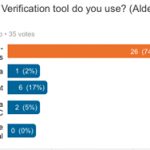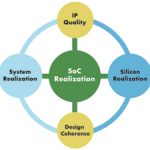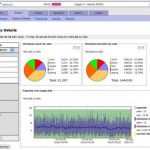You are currently viewing SemiWiki as a guest which gives you limited access to the site. To view blog comments and experience other SemiWiki features you must be a registered member. Registration is fast, simple, and absolutely free so please,
join our community today!
WP_Term Object
(
[term_id] => 157
[name] => EDA
[slug] => eda
[term_group] => 0
[term_taxonomy_id] => 157
[taxonomy] => category
[description] => Electronic Design Automation
[parent] => 0
[count] => 4360
[filter] => raw
[cat_ID] => 157
[category_count] => 4360
[category_description] => Electronic Design Automation
[cat_name] => EDA
[category_nicename] => eda
[category_parent] => 0
[is_post] =>
)
I had no idea that there was a clock domain crossing (CDC) linkedIn group but indeed there is. Richard Brabant has set up a survey to see which tools people are using.
The graph is somewhat confusing since, for example, Cadence Conformal is currently at zero but has a significant looking bar. But far and away the market leader (in this… Read More
Designing custom IP blocks is a challenge at the transistor-level and I wanted to learn what the recommended methodology and EDA tool flow was at Synopsys. They have a webinar that you can register for and it takes 30 minutes to learn what they have to say, or you can read a White Paper. If you cannot spare that much time, then my summary… Read More
I have recently blogged about Synopsys offensive in the Verification IP market. Did Synopsys again launched a new product, or announced a new acquisition? This would be a serious topic to blog, but today’s blog is closer to gaming than market analysis. Sometimes it’s good to have fun, even if the topic is serious! In fact, Synopsys… Read More
Last week I had an interesting meeting with GLOBALFOUNDRIES executives Kevin Meyer and Mojy Chian. It certainly seems that GFI has turned a corner! I will be in Dresden next week for DATE 2012 and will also visit the GFI Fab there. 28nm and 20nm are on track so expect an aggressive implementation plan from GFI this year.… Read More
International Gathering for Application Developers!
Commercial & Academic
July 16-19, 2012, Las Vegas, USA
ersaconf.org/ersa-news
…
Read More
Now that the dominant approach to building an SoC is to get IP from a number of sources and assemble it into a chip, the issue of IP quality is more and more critical. A chip won’t work if the IP doesn’t work, but it is quite difficult to verify this because the SoC design team is not intimately familiar with the IP blocks since… Read More
Last May, Atrenta and TSMC announced the Soft-IP Alliance Program which uses SpyGlass and a subset of its GuideWare reference methodology to implement TSMC’s IP quality assessment program. TSMC requires all soft-IP providers to reach a minimum level of completeness before their IP is listed on TSMC online. Since TSMC … Read More
July 16-19, 2012, Monte Carlo Resort, Las Vegas , Nevada , USA
ERSA-News: ERSA-NEWS ERSA’12 Website: http://ersaconf.org/ersa12
… Read More
CEO Forecast Panelby Paul McLellan on 03-02-2012 at 2:40 pmCategories: EDA, Events
This year’s CEO forecast panel was held at Silicon Valley Bank. Bankers live better than verification engineers, as if you didn’t know, based on the quality of the wine they were serving compared to DVCon.
This year the panelists were Ed Cheng from Gradient, Lip-Bu, Aart and Wally (and if you don’t know who they… Read More
Farm Managementby Paul McLellan on 03-01-2012 at 5:34 pmCategories: EDA
Every so often I come across a new company in EDA or one of its neighboring domains, new to me anyway, and new to SemiWiki. One such company is RunTime Design Automation (RTDA). They provide a suite of tools for managing server farms (or internal clouds which seems to be the trendy buzzword du jour). Running a few EDA scripts on a few servers… Read More












Quantum Computing Technologies and Challenges